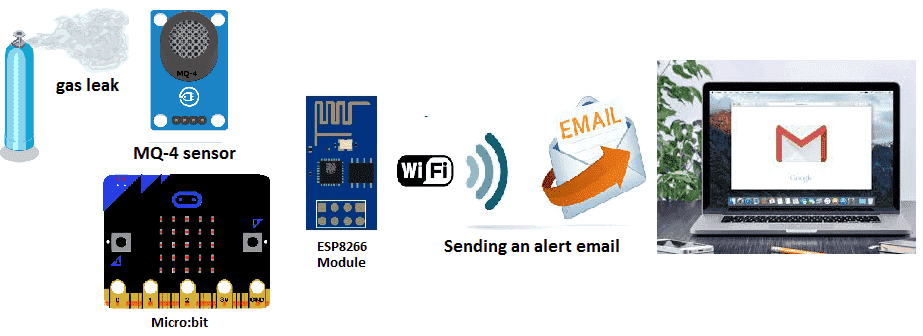
Intelligent gas leak detection system with Micro:bit

Presentation of gas leak detection system
A gas leak detection system is a system that is used to detect the presence of gas leaks in a specific area. These systems can be used in a variety of settings, such as homes, commercial buildings, and industrial facilities, to detect leaks in gas pipelines, tanks, and other equipment.
Gas leak detection systems typically consist of a combination of sensors and control equipment. The sensors are used to detect the presence of gas in the air, while the control equipment is used to process the sensor data and trigger an alarm or other response in the event of a gas leak.
There are several types of gas sensors used in gas leak detection systems. These include:
- Infrared sensors, which detect gas based on the absorption of infrared radiation.
- Catalytic bead sensors, which detect gas based on a chemical reaction between the gas and a catalytic bead.
- Metal oxide semiconductor sensors, which detect gas based on a change in electrical resistance.
Once a gas leak is detected, the control equipment can trigger an alarm or other response, such as shutting off the gas supply to the affected area, activating ventilation systems, or alerting emergency responders.
Gas leak detection systems can also be integrated with building management systems, providing real-time monitoring and control of gas levels.
In summary, a gas leak detection system is a system that detects the presence of gas leaks in a specific area, and triggers an alarm or other response when a leak is detected. The system is composed of sensors and control equipment, and can be integrated with building management systems for real-time monitoring and control.
A gas leak detection system integrated with IoT (Internet of Things) technology is a type of system that uses sensors to detect the presence of gas in the air, and then transmits sensor data to a remote monitoring station over a network using IoT devices, such as gateways and cloud-based platforms. This allows for real-time monitoring and control of gas levels from a remote location.
In an IoT gas leak detection system, the sensors are placed at strategic locations to detect the presence of gas. These sensors typically detect the concentration of gas in the air and transmit this data to a central control system. This system can then process the sensor data and trigger an alarm or other response in the event of a gas leak. The control system can also send alerts to a remote monitoring station, allowing for real-time monitoring of gas levels from a remote location.
IoT gas leak detection systems can also provide additional features such as remote control, real-time notifications, and historical data analysis. By using IoT technology, the system can be monitored and controlled from a remote location, and data can be analyzed to identify patterns and trends over time.
IoT gas leak detection systems can be used in a variety of settings, such as homes, commercial buildings, and industrial facilities. They can be integrated with building management systems, providing real-time monitoring and control of gas levels, and can also be integrated with other IoT devices to create an interconnected smart environment.
In summary, a gas leak detection system integrated with IoT technology is a type of system that uses sensors to detect the presence of gas in the air and transmits sensor data to a remote monitoring station over a network using IoT devices, allowing for real-time monitoring and control of gas levels from a remote location. It also provides additional features such as remote control, real-time notifications, and historical data analysis, and can be integrated with other IoT devices to create an interconnected smart environment.
Presentation of Intelligent gas leak detection system with Micro:bit
A gas leak detection system that utilizes a Micro:bit microcontroller and IoT (Internet of Things) technology is a type of system that uses sensors to detect the presence of gas in the air, and then transmits sensor data to a remote monitoring station over a network using IoT devices, such as gateways and cloud-based platforms, while using a Micro:bit microcontroller to process the sensor data and trigger an alarm or other response in the event of a gas leak.
The Micro:bit board is a small, programmable microcontroller board that can be easily integrated with sensors and other electronic components, making it a suitable option for gas leak detection system. The Micro:bit can be programmed to read data from the gas sensor and process the information, while the IoT device, such as ESP8266, can be used to connect the system to a WiFi network and transmit data to a remote server or other device.
Once a gas leak is detected, the Micro:bit can trigger an alarm or other response, such as activating ventilation systems, or alerting emergency responders via the IoT device. The system can also send data to a remote server for monitoring and analysis.
This type of system provides many benefits such as remote monitoring and control, real-time notifications and historical data analysis. The Micro:bit provides an easy to use and accessible platform for students and educators, and the integration with IoT technology allows for scalable and flexible solutions.
In summary, a gas leak detection system that utilizes a Micro:bit microcontroller and IoT technology is a type of system that uses sensors to detect the presence of gas in the air and transmits sensor data to a remote monitoring station over a network using IoT devices, and uses a Micro:bit microcontroller to process the sensor data and trigger an alarm or other response in the event of a gas leak. It provides benefits such as remote monitoring and control, real-time notifications and historical data analysis, and it is easy to use and accessible platform for students and educators.
Purpose of this project:
In this project we will realize a gas leak detection system controlled by the Micro:bit card connected to the Internet.
It mainly uses MQ-4 gas sensor. When the sensor detects gas leak, Micro:bit card will send email alert by WIFI.
Note: To connect the Micro: bit card to the Internet you can see this article:
Necessary components
Micro:bit

Micro:bit is a small programmable microcontroller board developed by the BBC for use in educational settings. It is designed to be easy to use and accessible to students of all ages and skill levels. The board measures 4×5 cm and has 25 red LED lights that can be programmed to display messages or animations. It also includes 2 programmable buttons, accelerometer, magnetometer, and a Bluetooth Low Energy (BLE) module.
Micro:bit is powered by a 32-bit ARM Cortex-M0 CPU and has 256KB of flash memory and 16KB of RAM. It can be programmed using a variety of programming languages, such as MakeCode, Python, and JavaScript. It also supports a variety of sensors and actuators, allowing for the creation of interactive projects and applications.
The Micro:bit is an excellent tool for learning programming, electronics, and physical computing. It is used in many school curriculum as part of STEM education. Some examples of projects that can be built with Micro:bit include a pedometer, a digital compass, a weather station, and a musical instrument.
Micro:bit GPIO board
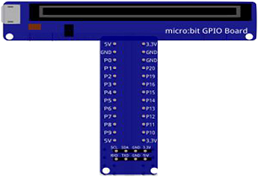
A Micro:bit GPIO (General Purpose Input/Output) board is an expansion board that connects to the Micro:bit microcontroller board and provides additional input/output (I/O) pins, allowing for more advanced projects and applications. The Micro:bit has a limited number of I/O pins on the board itself, and the GPIO board can add more capabilities to the Micro:bit by adding more pins.
The GPIO board usually provides a set of connectors and headers that match the pinout of the Micro:bit, allowing for a simple and easy connection. The board typically provides additional input and output interfaces, such as digital and analog inputs, digital outputs, PWM, I2C, and UART communication interfaces.
The additional I/O pins on the GPIO board allow the Micro:bit to interface with a wide range of electronic devices and sensors, such as LEDs, buttons, motors, sensors, and other electronic devices. It also allows for more complex projects to be created, such as robots, home automation systems, and IoT applications.
MQ-4 gaz sensor
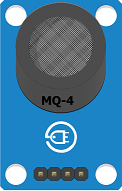
The MQ-4 gas sensor is a type of gas sensor that is used to detect the presence of methane (CH4) gas. It is a highly sensitive sensor that can detect methane gas concentrations as low as 200ppm (parts per million). It is often used in applications such as natural gas leakage detection, home gas leak alarms, and industrial process control.
The MQ-4 sensor consists of a sensing element, typically made of tin dioxide (SnO2), that is sensitive to methane gas. When methane gas is present, it is adsorbed by the sensing element, which causes a change in the electrical resistance of the element. This change in resistance is then converted into a corresponding output signal that can be read by a microcontroller or other electronic device.
The MQ-4 sensor has a fast response time and a long service life, making it a suitable option for gas leak detection. The sensor also has a wide operating temperature range and it can be used in both indoor and outdoor applications.
The sensor typically interfaces with a microcontroller, such as an Arduino or Micro:bit, and can be programmed to trigger an alarm or other response when a gas leak is detected. It also can be integrated with IoT devices to provide remote monitoring and control of gas levels and real-time notifications.
ESP8266 wifi

ESP8266 is a low-cost Wi-Fi microcontroller chip with full TCP/IP stack and microcontroller capability. It is produced by Espressif Systems, a Chinese manufacturer. It can be used to add Wi-Fi connectivity to devices such as microcontrollers, and it is often used in Internet of Things (IoT) projects.
The ESP8266 chip includes a 32-bit processor, flash memory, and a built-in Wi-Fi module, making it a complete solution for adding Wi-Fi connectivity to a device. It can be easily integrated with a microcontroller, such as an Arduino or a Micro:bit, and can be programmed using a variety of programming languages, such as C, C++, and Python.
The ESP8266 can be used in a variety of projects, such as wireless sensor networks, home automation systems, and web-connected devices. It can be programmed to connect to a Wi-Fi network, send and receive data, and interact with other devices over the Internet. The chip has a very small form factor and low power consumption, making it ideal for battery-powered devices.
In summary, the ESP8266 is a popular, low-cost, and versatile Wi-Fi module that can be used to add wireless connectivity to a variety of devices and projects. It offers a complete solution for IoT projects, and its small form factor and low power consumption make it ideal for battery-powered applications.
Connecting wires

Connecting wires refer to the process of connecting two or more electrical wires together in order to transmit electrical signals or power from one device to another. This can be done using a variety of methods and techniques, depending on the type of wire and the application.
Test plate

A test plate is used to include the flame sensor module, as well as connectors and other components to interface the sensor with the Micro:bit. It may also include LEDs, buttons or other input/output devices to test the functionality of the sensor and the microcontroller. The test plate allows for easy testing and validation of the sensor and the Makecode that is used to interact with it.
Mounting:
To perform the assembly, you can connect:
For MQ-4 sensor :
-
the DO pin to the P2 pin of the Micro:bit card
-
the VCC pin to the 5V pin of the GPIO card
-
the GND pin to the GND pin of the Micro:bit card
For ESP8266 module:
-
the RX pin to Pin P0 of the Micro:bit card
-
the TX pin to Pin P1 of the Micro:bit card
-
the GND pin to the GND of the Micro:bit card
-
the two pins 3V3 and EN to the 5V pin of the power supply module
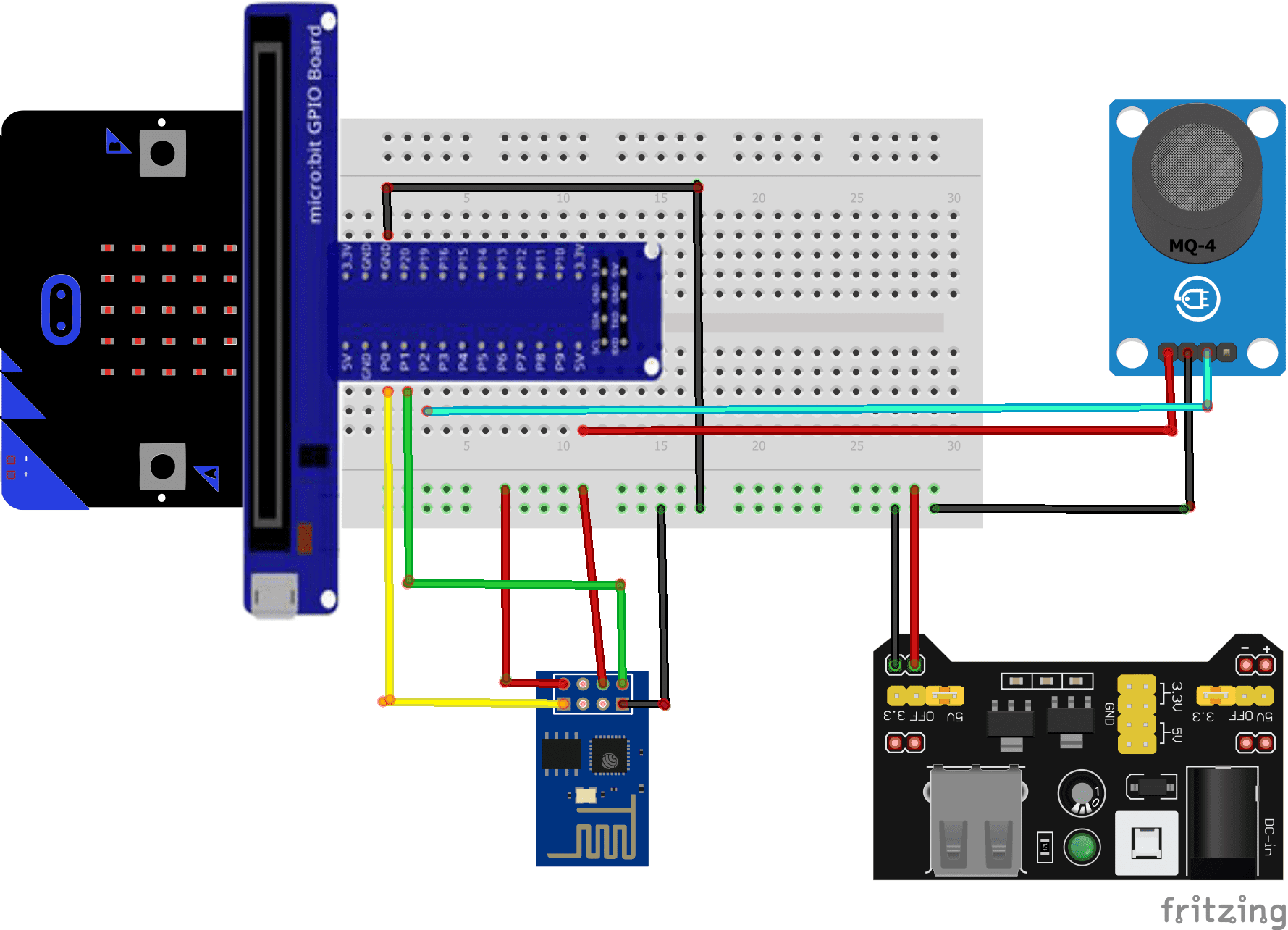
Makecode program:
Here is the program of the intelligent gas leak detection system connected to the Internet:
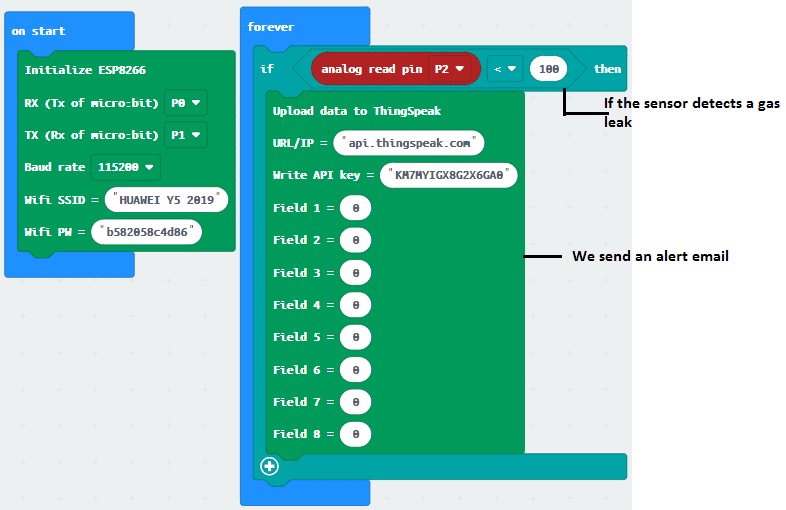

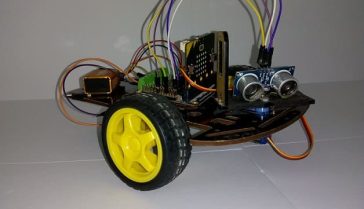
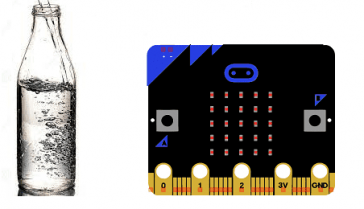

















tachinid 03-11-2323
Tһanks for one's marvelous posting! Ι գuite enjoyed reading іt, you're a great author.I will always bookmark your blog and definitely will come back ⅼater in life. Ι want to encourаge you to ultіmately continuе your grеat job, haᴠe a nice evening!